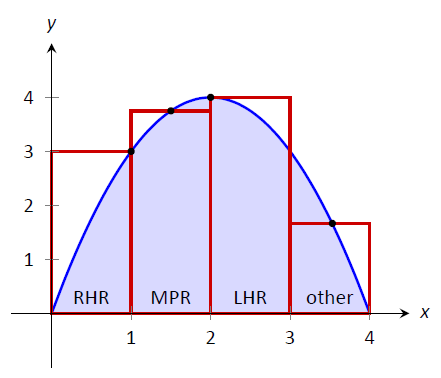💻 Activity 6.3: Advancing integral evaluations by combining loops and branches#
We wanted to explore how two important choices impact the accuracy of this method for approximating integrals.
✅ 1. the width of the rectangle \(h\), which is determined by the number of rectangles between \(a\) and \(b\)
Now, let’s explore
the value of \(x\) at which the function is evaluated (left, midpoint, or right)

Interact with the code#
Add the branching structure inside the current function to cause different calculations to occur if the
evalPointvariable is"right", "mid", or "left".Include an extra case in which the user receives a helpful message if the string for
evalPointis not one of the three options.
import numpy as np
def reimann(numRectangles,evalPoint):
# define the boundaries of the integral
a = 0
b = 5
# define the curve
x = np.linspace(a,b,numRectangles)
f = np.sin(x/2)+1
### determine the width of the rectangle
h = ...
integral_R = 0.
# add branching structure for evalPoint to calculate the integral in three different ways
# integrate using the value of f at the right
for i in range(...):
if i < (numRectangles-1):
integral_R += h * f[i+1]
# print the integral, number of rectangles, and the chosen point for evaluation
print(f'The integral is {integral_R} for {numRectangles} using the {evalPoint} point for evaluating the function.')
Consider how the calculation at the left side of the rectangle or the midpoint would differ from the right.
Copy the
forloop from the right-side calculation into each branch and make the few necessary changes to calculateintegral_Rusing these two different approaches.
import numpy as np
def reimann(numRectangles,evalPoint):
# define the boundaries of the integral
a = 0
b = 5
# define the curve
x = np.linspace(a,b,numRectangles)
f = np.sin(x/2)+1
### determine the width of the rectangle
h = ...
integral_R = 0.
j = 1
# add branching structure for evalPoint to calculate the integral in three different ways
# print the integral, number of rectangles, and the chosen point for evaluation
print(f'The integral is {integral_R} for {numRectangles} using the {evalPoint} point for evaluating the function.')
Explore how both the number of rectangles and the point at which the function is evaluated influence the resulting integral.
Is a higher or lower number of rectangles better?
Is the “left”, “right”, or “mid” point best?
# call the function with two arguments
# - one integer for the number of rectangles
# - one string for the "right" method
# 2 rectangles, right
reimann()
# 2 rectangles, left
reimann()
# 2 rectangles, mid
reimann()
# 5 rectangles, right
reimann()
# 5 rectangles, left
reimann()
# 5 rectangles, mid
reimann()
# 11 rectangles, right
reimann()
# 11 rectangles, left
reimann()
# 11 rectangles, right
reimann()


